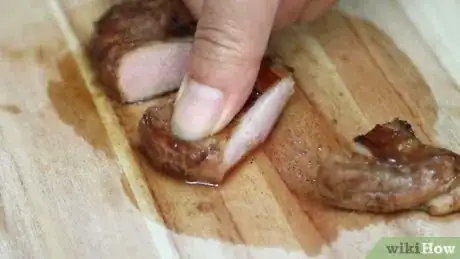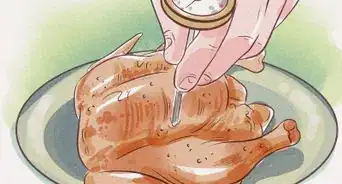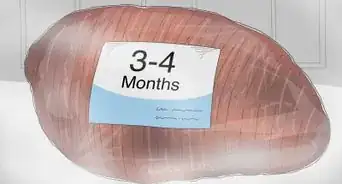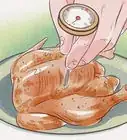This article was co-authored by wikiHow Staff. Our trained team of editors and researchers validate articles for accuracy and comprehensiveness. wikiHow's Content Management Team carefully monitors the work from our editorial staff to ensure that each article is backed by trusted research and meets our high quality standards.
There are 7 references cited in this article, which can be found at the bottom of the page.
The wikiHow Video Team also followed the article's instructions and verified that they work.
This article has been viewed 264,146 times.
Learn more...
It’s important to cook pork thoroughly to avoid getting sick. Generally speaking, all pork needs to be cooked to at least 145 °F (63 °C) to be safe to eat (or 160 °F (71 °C) for ground pork), and a thermometer is the best way to keep track of cooking temperatures as you go. If you don’t have a thermometer, however, there are still ways to know if your pork is cooked enough to be safe to eat.
Steps
Signs that Pork is Cooked
Using a Continuous Read Thermometer
-
1Make sure the pork is at least 1 inch (2.5 cm) thick. The pork will need to be thick enough for you to leave the thermometer probe inserted throughout cooking, so some cuts of pork may not be appropriate for a continuous read thermometer. Anything one inch or thicker should be fine.[1]
- Thin cuts of pork are not well suited for leaving a thermometer inserted throughout cooking.
- Ribs and bacon may be too thin to use a thermometer.
-
2Prepare the pork to be cooked. A continuous read thermometer is meant to stay in the pork throughout its cooking time, but you’ll want to do any preparations, brines, and the like before inserting it.[2]
- You can insert the thermometer first, but it may get in the way of your preparations.
Advertisement -
3Insert the thermometer in the thickest part of the meat. You’ll want to stick the thermometer in the middle of the cut of pork, because that’s the last part that will reach proper temperature.[3]
- Keep the thermometer away from bone in the pork, as it may affect its readings.
- If the pork is less than an inch thick, you may be able to insert the thermometer from the side, otherwise, it may be easiest just to insert it from the top.
-
4Wait until the thermometer reads at least 140 °F (60 °C). According to the USDA, pork needs to be cooked to between 145 °F (63 °C) and 160 °F (71 °C) in order to be safe to eat. However, you can take the pork out of the oven a few degrees prior to the 145 mark to avoid overcooking.[4]
- The internal temperature of the pork will continue to rise once you take it out, regardless of whether you cooked it in the oven or a slow cooker.
- Never eat pork that hasn’t had its internal temperature brought up to at least 145 °F (63 °C).
- With ground pork, 160 °F (71 °C) should be treated as the lowest number, rather than 140 °F (60 °C).
-
5Take the pork out of the oven and let it sit. Although you may remove the pork a few degrees before it reached the recommended temperature, heat from the outside portions of the meat will continue to spread into the middle, raising the temperature even out of the oven.[5]
- Let a thick cut of pork (1 inch (2.5 cm) or bigger) rest for 15 minutes before eating, but thinner ones will take less time.
- Keep an eye on the thermometer to ensure it passes the 145 °F (63 °C) mark before serving. If it doesn’t, keep cooking it.
Checking Doneness with an Instant Thermometer
-
1Cook the pork with the thermometer handy. An instant thermometer isn’t meant to be left in the cut of meat as it cooks. Instead, you will need to periodically insert the thermometer probe into the pork to check its internal temperature.[6]
- Unlike a continuous read thermometer, an instant thermometer must be inserted and removed each time you check.
- Do not use an instant surface thermometer, as it won’t tell you internal cooking temperatures.
-
2Remove the pork from the oven periodically to check the temperature. While some people may want to check the temperature of the pork without pulling the whole pan from the oven, the high temperatures inside the oven make doing so unsafe.[7]
- Even if you’re not using an oven, remove the pork from the heat source before checking its temperature.
- Checking the temperature while still on the stove or in the oven may also affect the thermometer’s reading.
-
3Insert the instant thermometer in the middle of the pork. Like a continuous read thermometer, you’ll want to insert your instant thermometer into the thickest portion of the cut of meat. Keep it away from any bones as that can have an effect on its reading.[8]
- If the meat is less than 1 inch (2.5 cm) thick, you may want to insert the thermometer probe horizontally instead of from the top.
- Be sure to remove the thermometer again before putting the pork back on or in its heat source.
-
4Place the pork back in the oven until it reaches at least 140 °F (60 °C). If you’re using a recipe, it may offer guidance as to how long the pork needs to cook, but you should not rely on the timeframe provided. Check the pork periodically and continue cooking it until it hits a minimum of 140 °F (60 °C), or 160 °F (71 °C) for ground pork.[9]
- Remember, the pork will continue to cook after you remove it from the heat source.
-
5Remove the pork from the oven and let it sit. Once the pork is about 5 °F (−15 °C) below the preferred internal temperature, remove it from the heat source and let it sit for a few minutes before serving. Remember, the internal temperature must reach at least 145 °F (63 °C), so keep an eye on it to ensure it does.[10]
- An internal temperature of 145 °F (63 °C) would be considered “rare,” so you may choose to cook it longer.
- A temperature of 160 °F (71 °C) is usually considered well done.
- You don’t need to let ground pork sit after it’s done cooking.
Checking Doneness Without a Thermometer
-
1Check to see if the juices are clear. Although thermometers are the best way to determine if your pork is done cooking, you can gauge the doneness of pork by the color of the juices that come out of it when you poke a hole in it with a knife or fork.[11]
- If the juices that come out of the pork run clear or are very faintly pink, the pork is done cooking.
- If the juices are not clear, continue cooking the pork and check again later.
-
2Use a long knife to see if the pork is still tough inside. If you are slow cooking the pork, it will reach the necessary internal temperature long before the meat is as tender as you may intend. Use a long knife or a skewer to puncture the middle of the pork and assess the resistance it gives you as you press it in.[12]
- If the knife or skewer slides in and out easily, the center of the pork has become tender.
- If you hit resistance, allow the pork to continue to cook and try again after a few minutes.
-
3Cut into the pork to see if it’s opaque. For some cuts of pork not thick enough for thermometers, this may be your only way to assess doneness. Cut a slit into the thickest part of the pork, then pull it apart with a knife and fork to gauge its internal color.[13]
- The pork should be opaque (solid in color) and may have a slight pinkish tint when done.
- Very thin cuts of pork like sliced bacon can be checked without cutting into them.
-
4Compare the pork’s firmness to the palm of your hand. For cuts of pork like chops and steaks, you can usually assess the meat’s doneness by pressing firmly into it with your tongs or fingers. Properly cooked pork will feel firm and quickly spring back into shape after you pull your fingers away. The pork should feel as firm as the center of your outstretched palm.
- If any juices squeeze out, they should be clear when the pork is done cooking.
- If the pork feels soft to the touch, it needs to keep cooking.
Things You’ll Need
- Instant or continuous read thermometer
- Oven mitts
- Baking sheet or frying pan
- Knife or skewer
References
- ↑ https://www.recipetips.com/kitchen-tips/t--461/pork-doneness.asp
- ↑ https://www.pork.org/cooking/pork-temperature/
- ↑ https://www.epicurious.com/expert-advice/how-to-use-a-meat-thermometer-article
- ↑ https://www.recipetips.com/kitchen-tips/t--461/pork-doneness.asp
- ↑ https://www.pork.org/blog/using-meat-thermometer/
- ↑ https://www.epicurious.com/expert-advice/how-to-use-a-meat-thermometer-article
- ↑ https://www.recipetips.com/kitchen-tips/t--461/pork-doneness.asp
- ↑ https://www.pork.org/blog/using-meat-thermometer/
- ↑ https://www.epicurious.com/expert-advice/how-to-use-a-meat-thermometer-article
About This Article
The easiest, safest way to tell if pork is cooked through is by using a thermometer. Just insert the thermometer in the thickest part of the meat since that’s the last part to reach the proper temperature. Wait until the thermometer reads at least 140 degrees Fahrenheit before taking it out of the oven. If you don't have a thermometer, you can also see if the juices are clear or light pink, which is a sign that the meat is fully cooked. You can also insert a knife into the pork to check for a tender middle. To learn how to tell if your pork is done by its internal color, keep reading!













-Step-11.webp)


















































